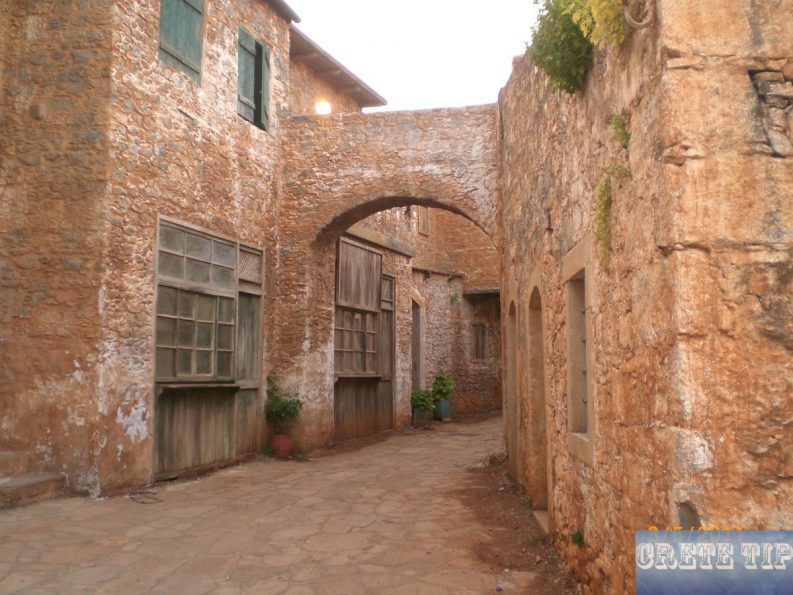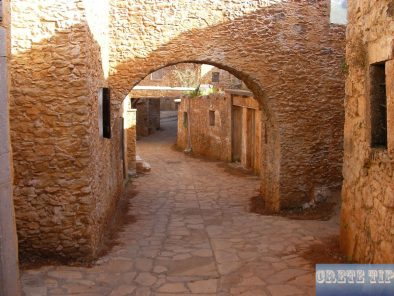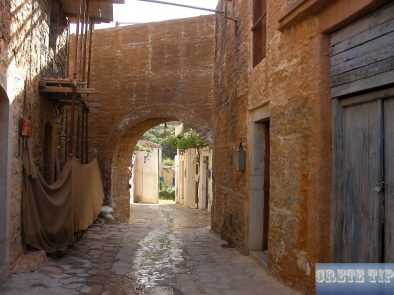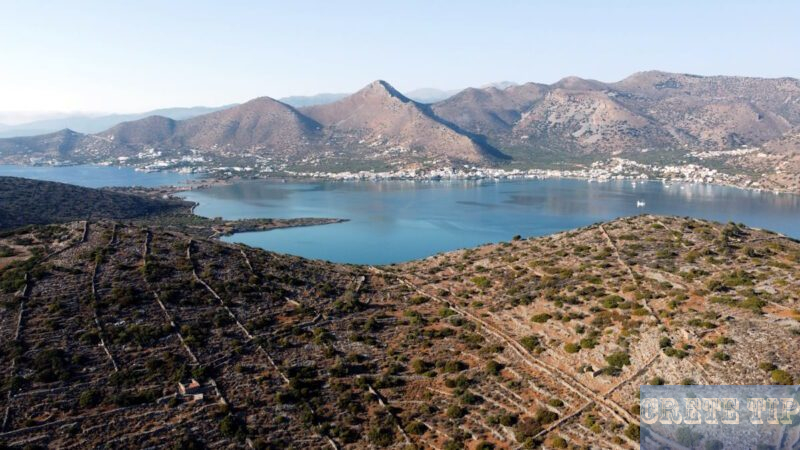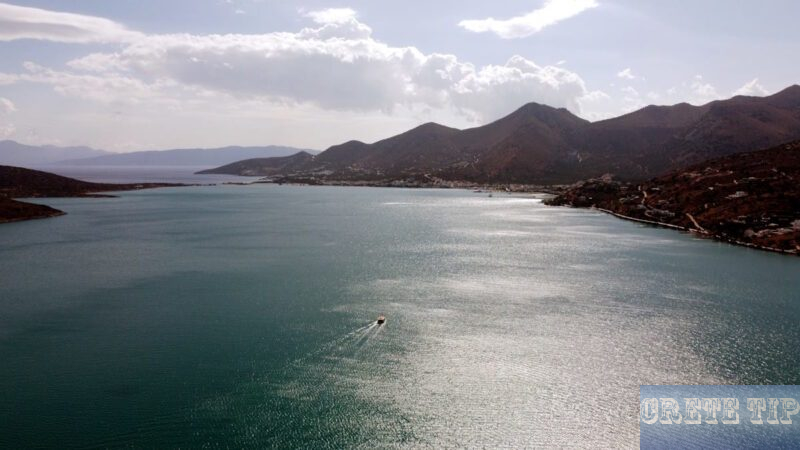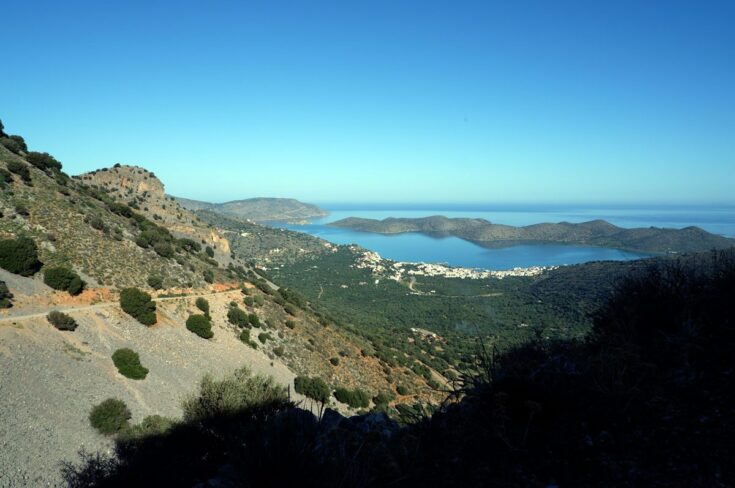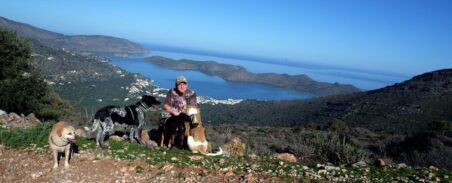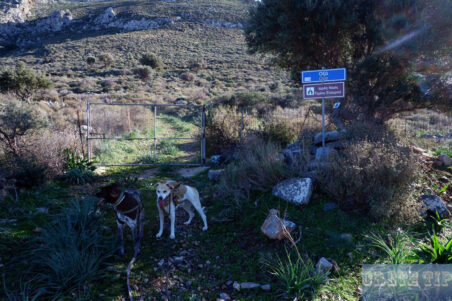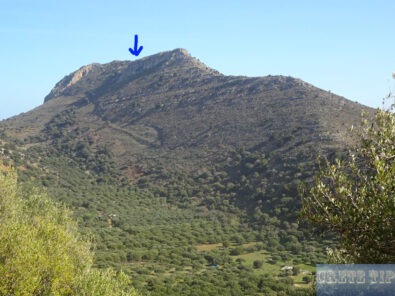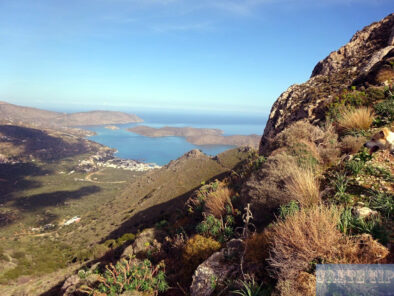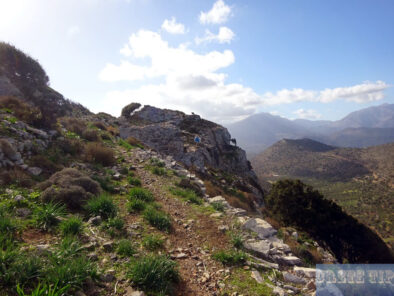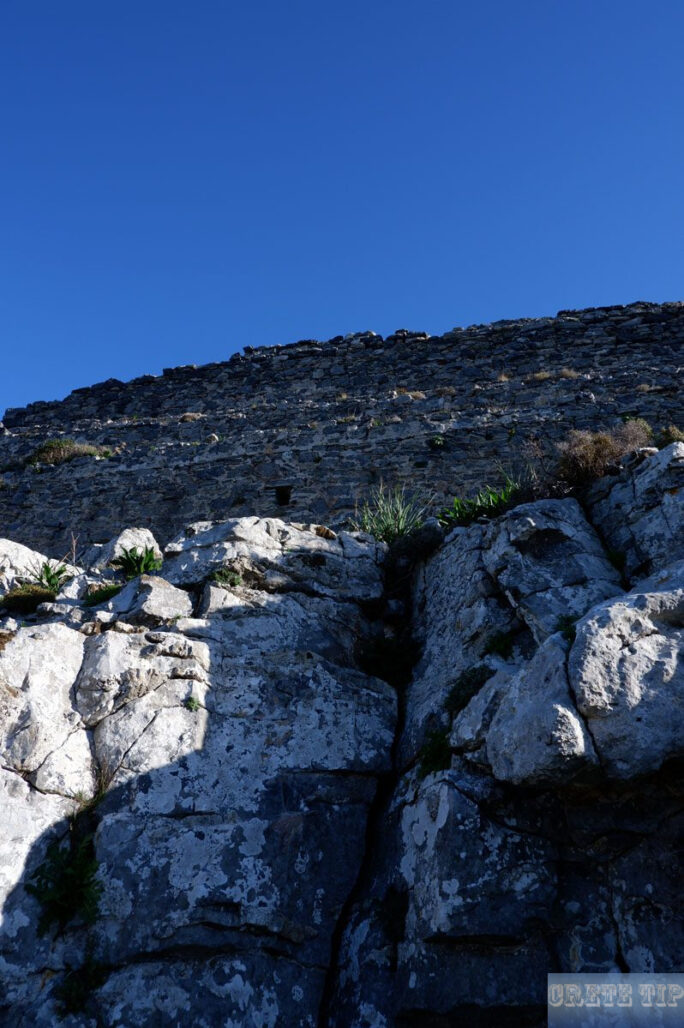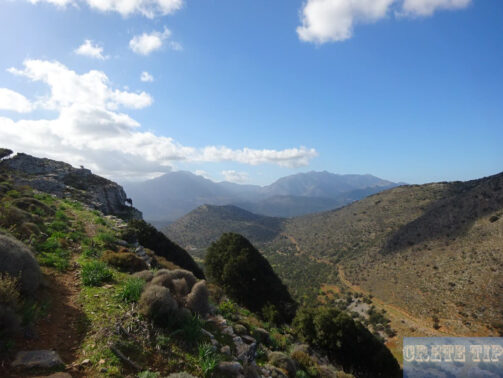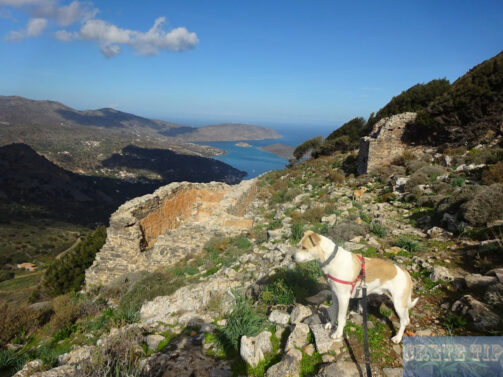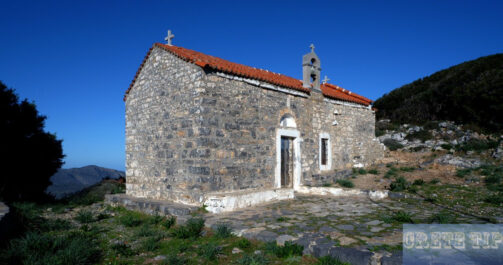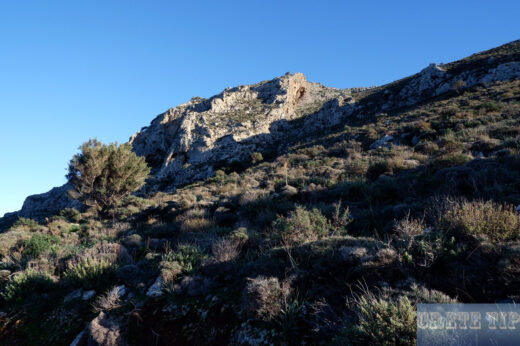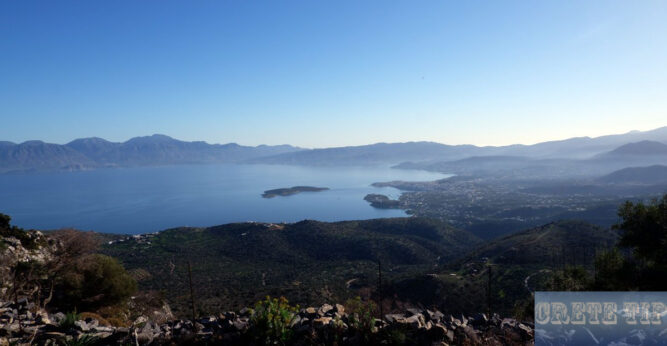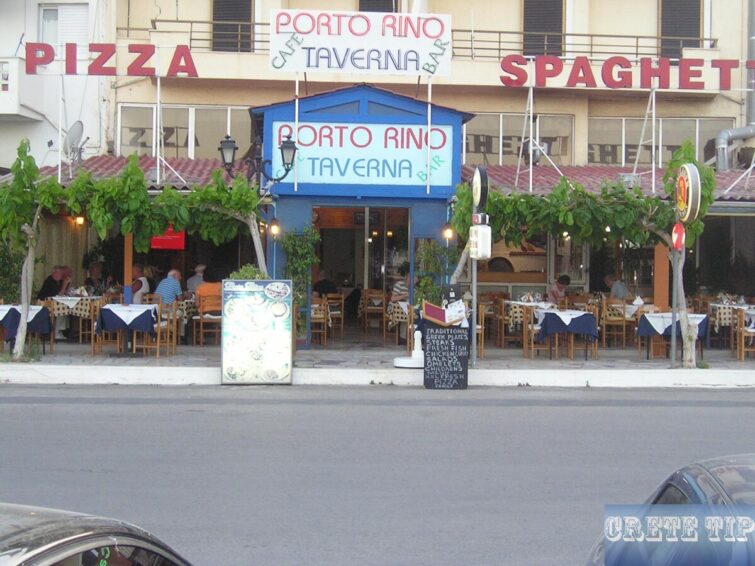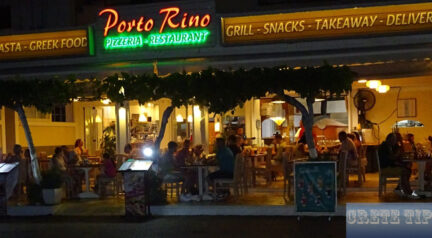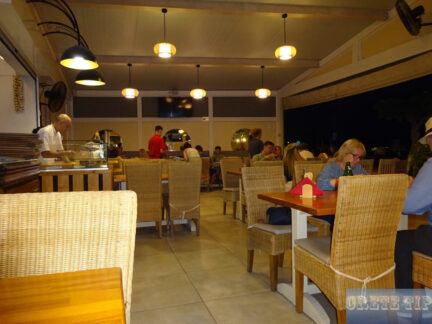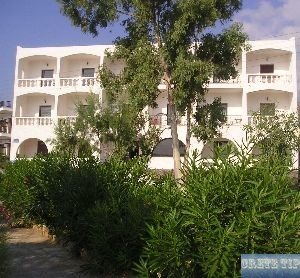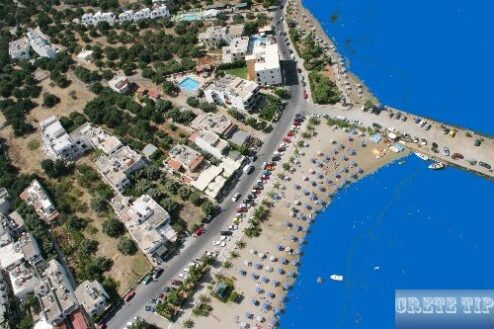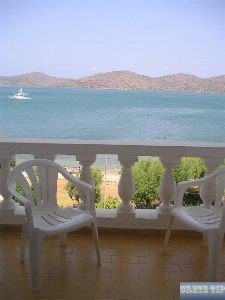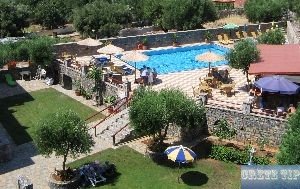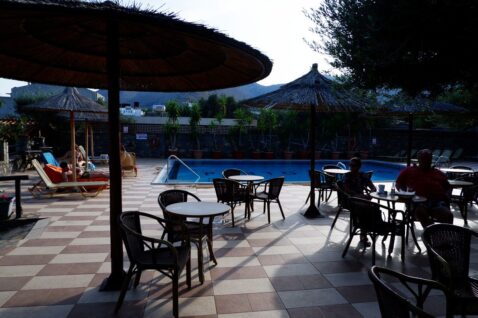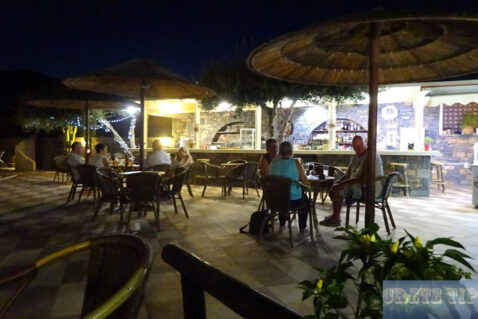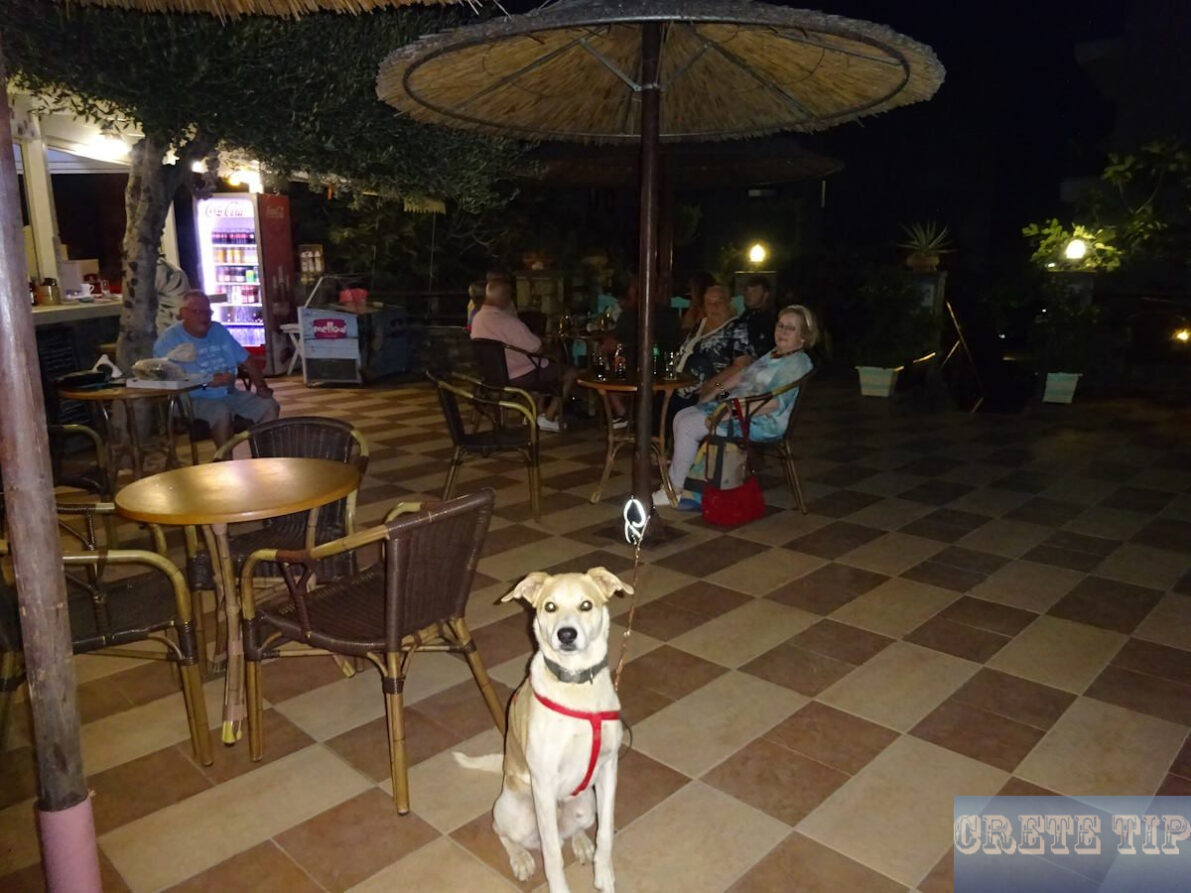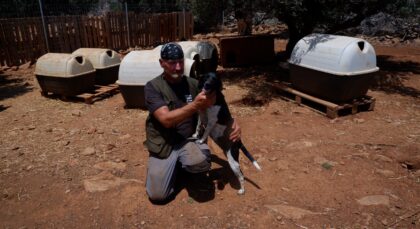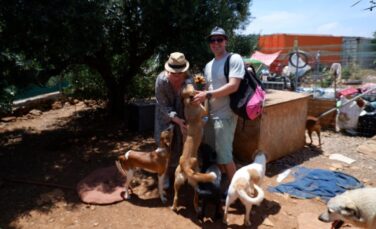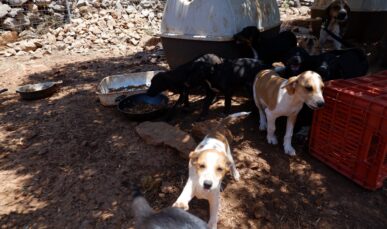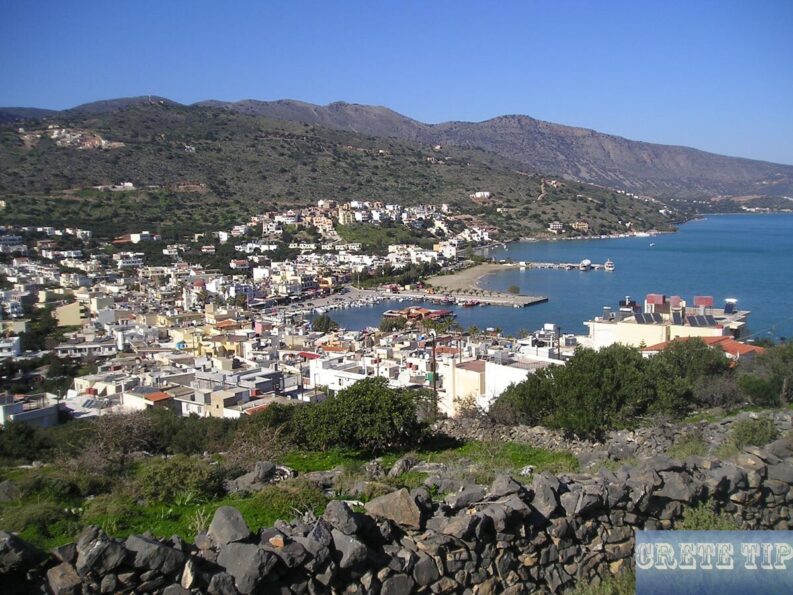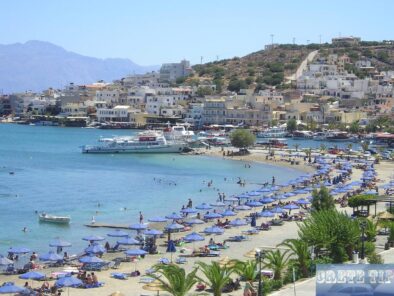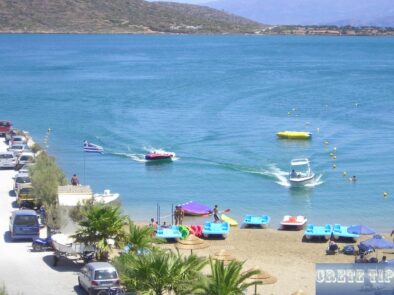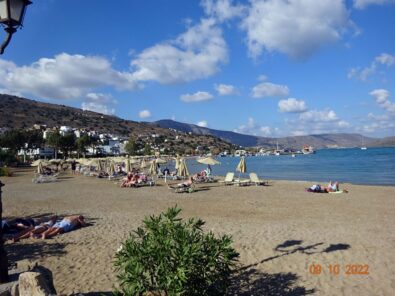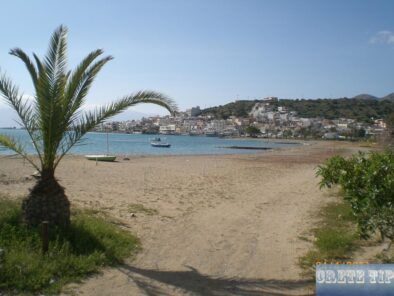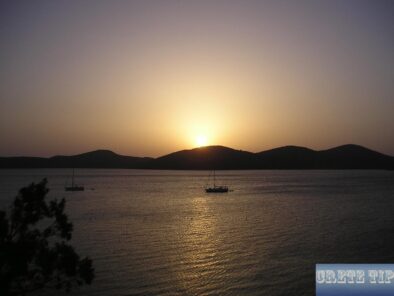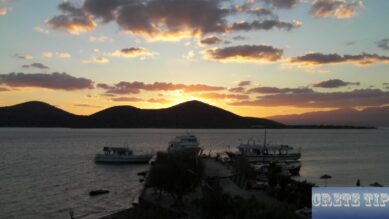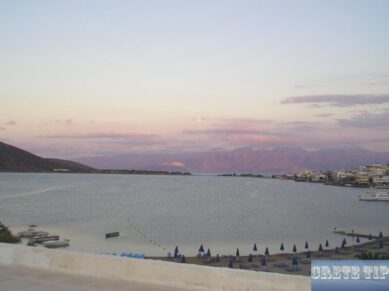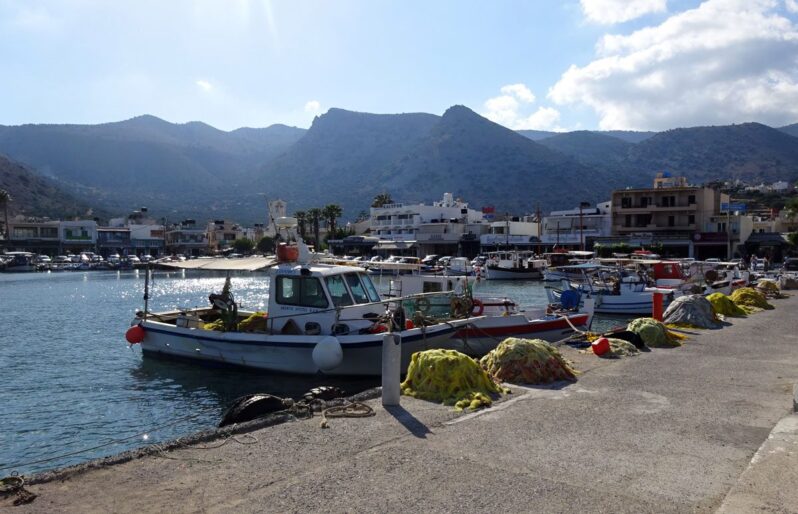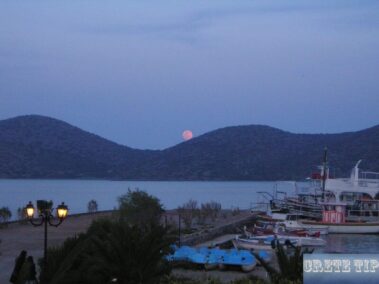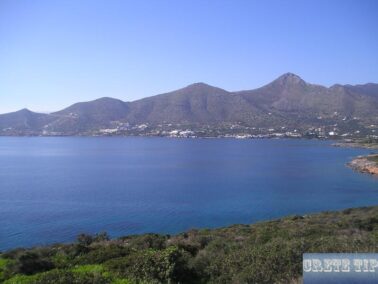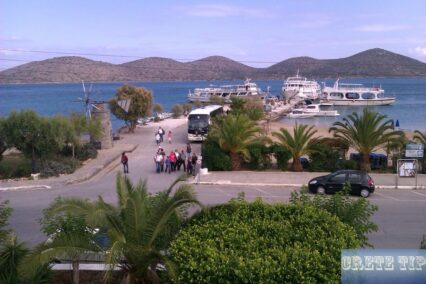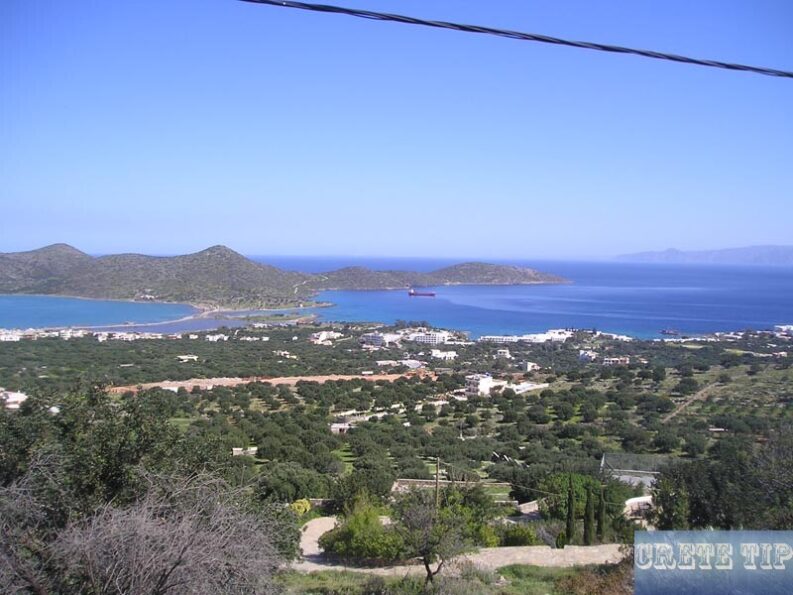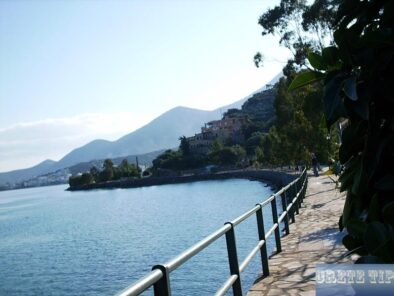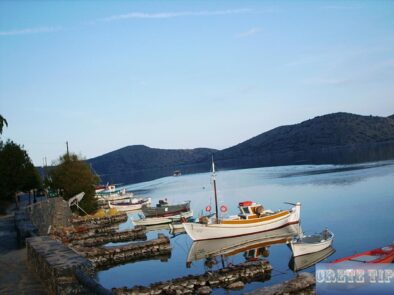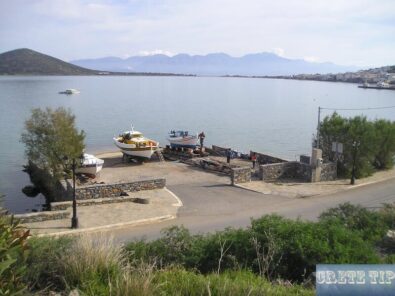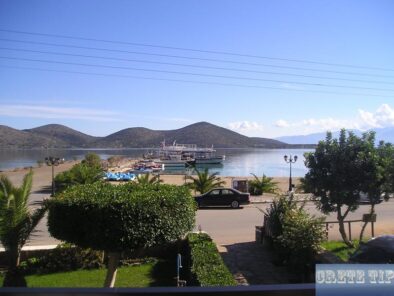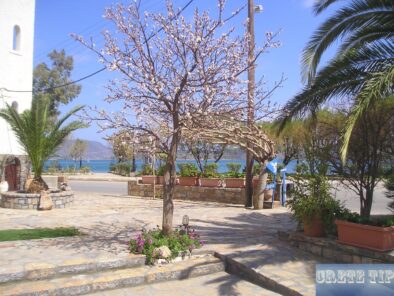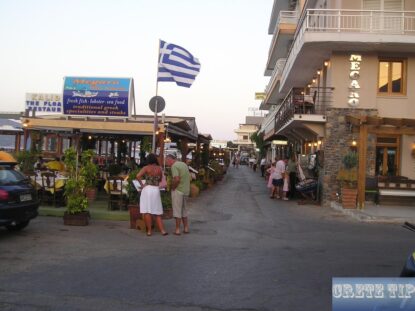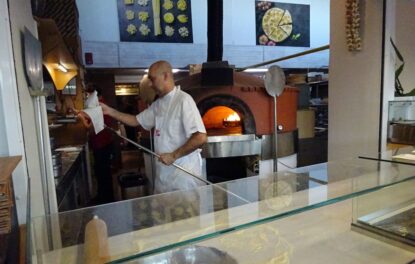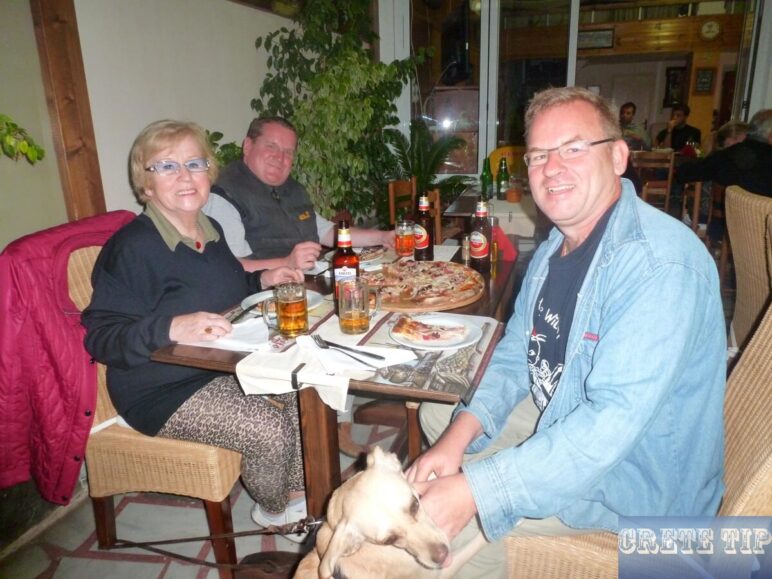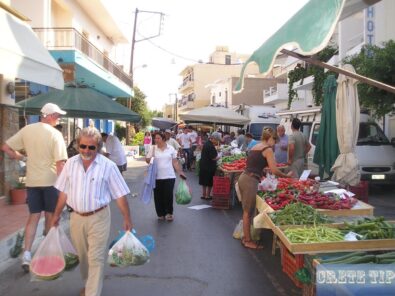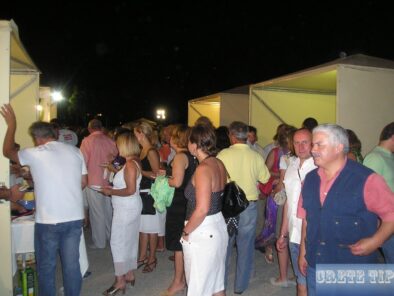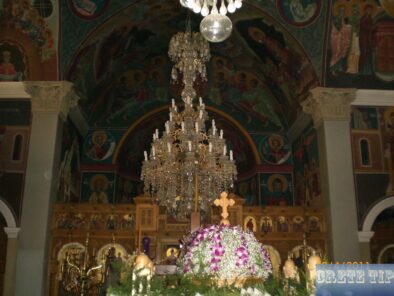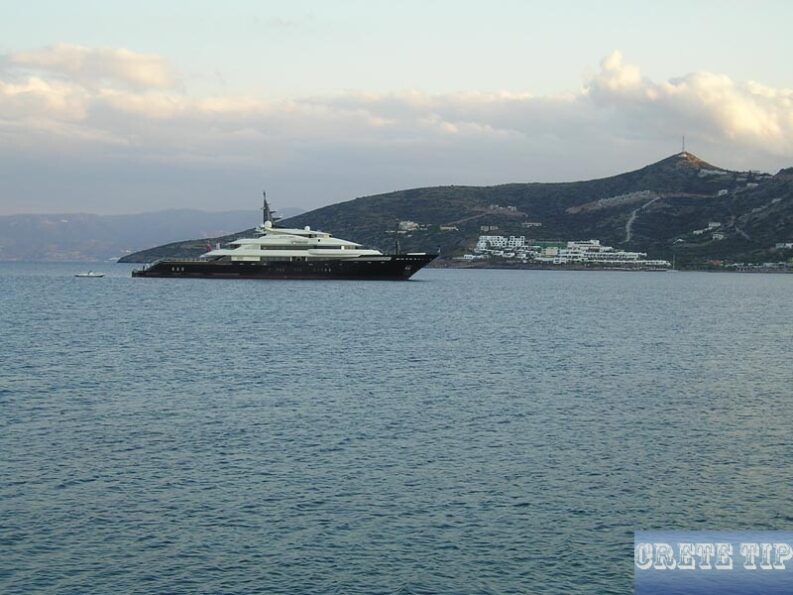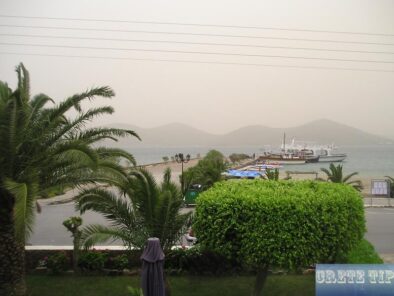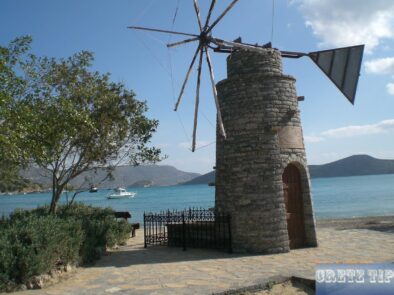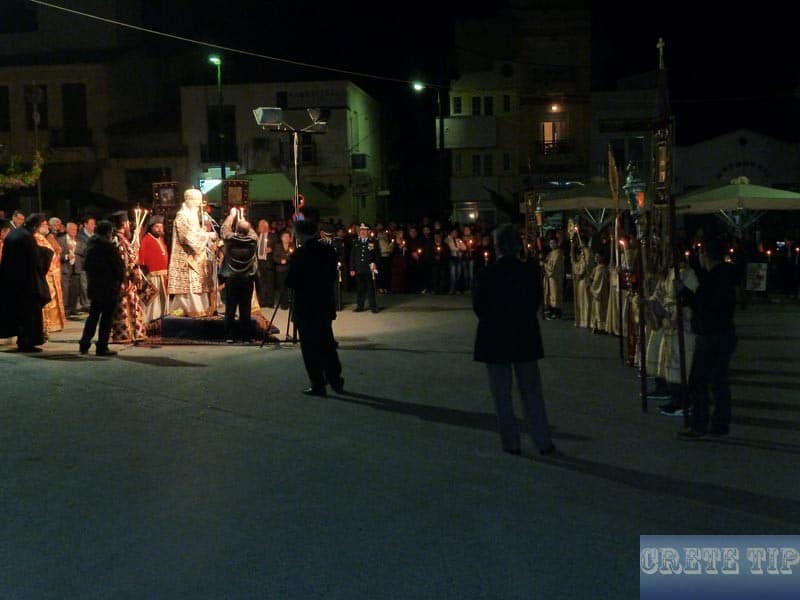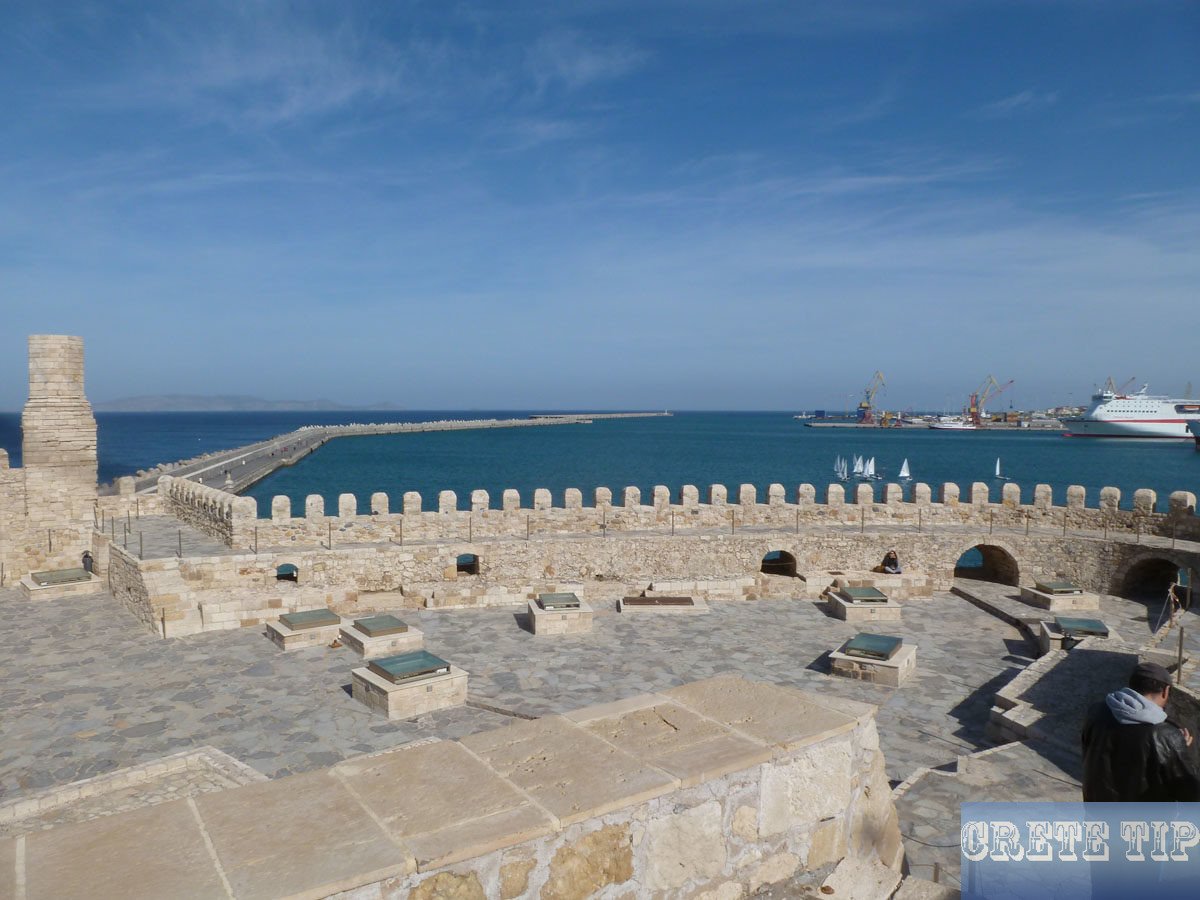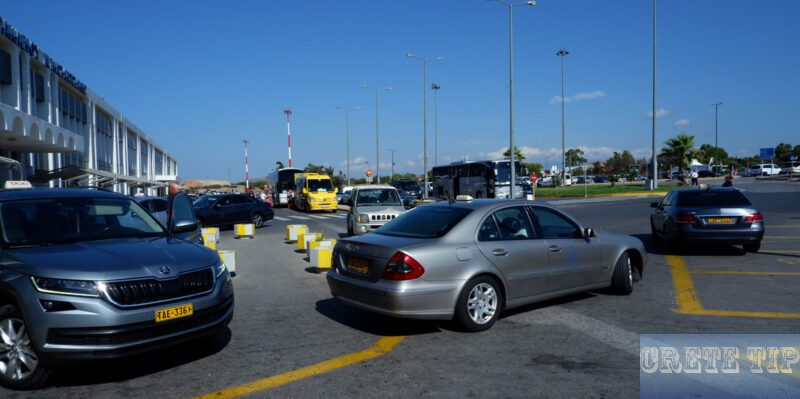Elounda is situated on the north-eastern coast of Crete, and nestles between the high rugged mountains and the clear blue sea close to the city of Aghios Nikolaous. The history, story, village life, pictures and video.
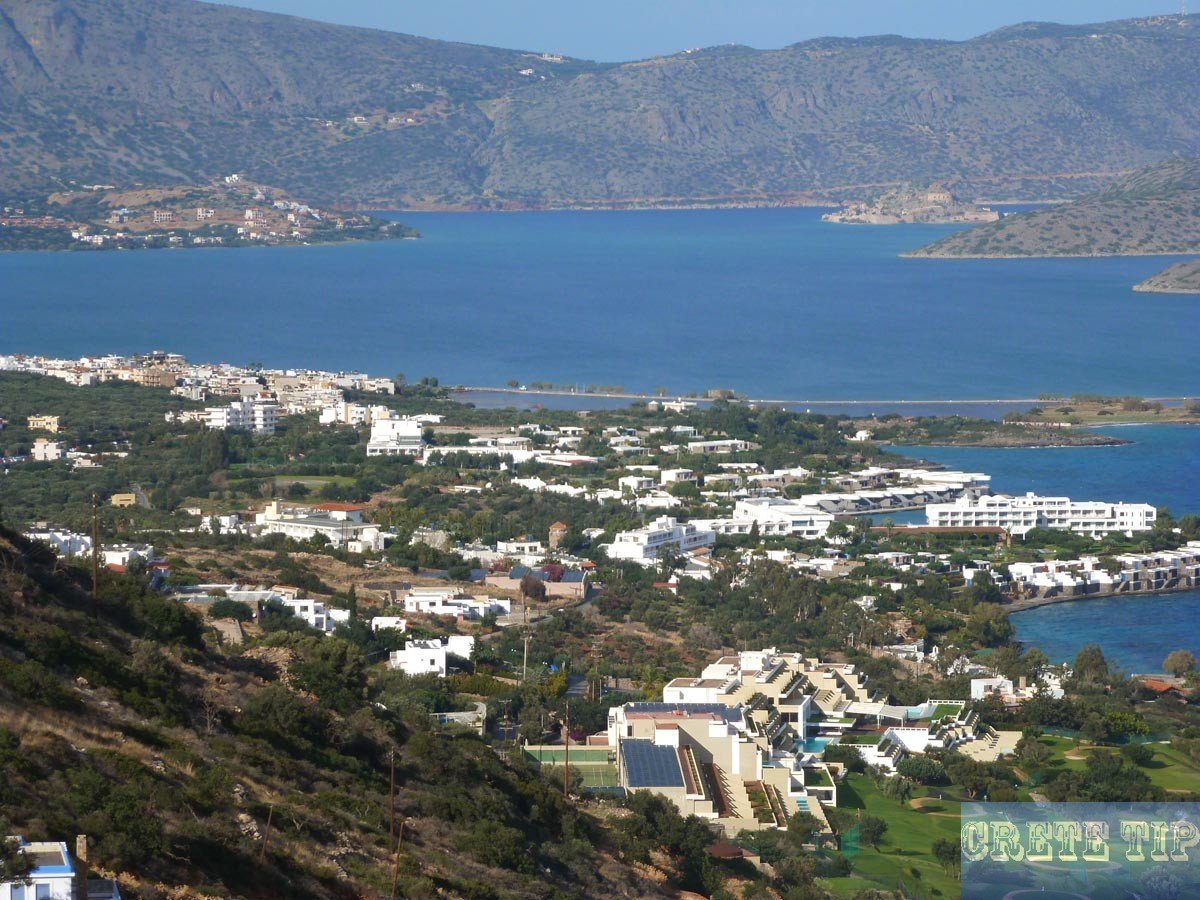
The story of Elounda.
Elounda on Crete
Table of Contents
From Aghios Nikolaous you head north toward the village on the coast road and after 6 km you reach the highest point of your excursion where you have an incredible, panoramic view of Elounda and the Gulf of Merabellou.
Before you is the site Trachili, a green landscape where the roofs of the bungalows look like daisies in a blooming meadow. To the back is bay of Poros and to its rear Schisma with the Spinalonga peninsula. Left are the mountains of Oxa, Karfi and Kefala with their deep green slopes.
At this point the road starts downhill and as soon as it reaches sea level the large hotel units begin and 10 km later you reach the village. Elounda is actually the name of the area, and it consists of four villages: Schisma, Mavrikiano, Kato Elounda and Pano Elounda. The name Elounda came about when the ancient Greek eis Olounda, which means to Olous, became shortened.
Elounda is a picturesque place with a small harbor full of fishing boats which is touristically developed with hotels, restaurants and coffeehouses.
On the eastern end of the village is the settlement of Schisma with three derelict stone windmills on a small opening towards the harbor through which only small boats can pass. A narrow bridge joins the mainland to the peninsula of Spinalonga.
History
The ancient town of Olous was located here, its ruins now under the surface of the sea. Pausanias mentions that in the 2nd century B.C. Olous was one of the few towns to have a statue of Britomartis, a work by Daedalus. Zeus Tallaios, Ares and Artemis Britomartis were worshipped in Elounda. It was, powerful, autonomous town with its own coins.
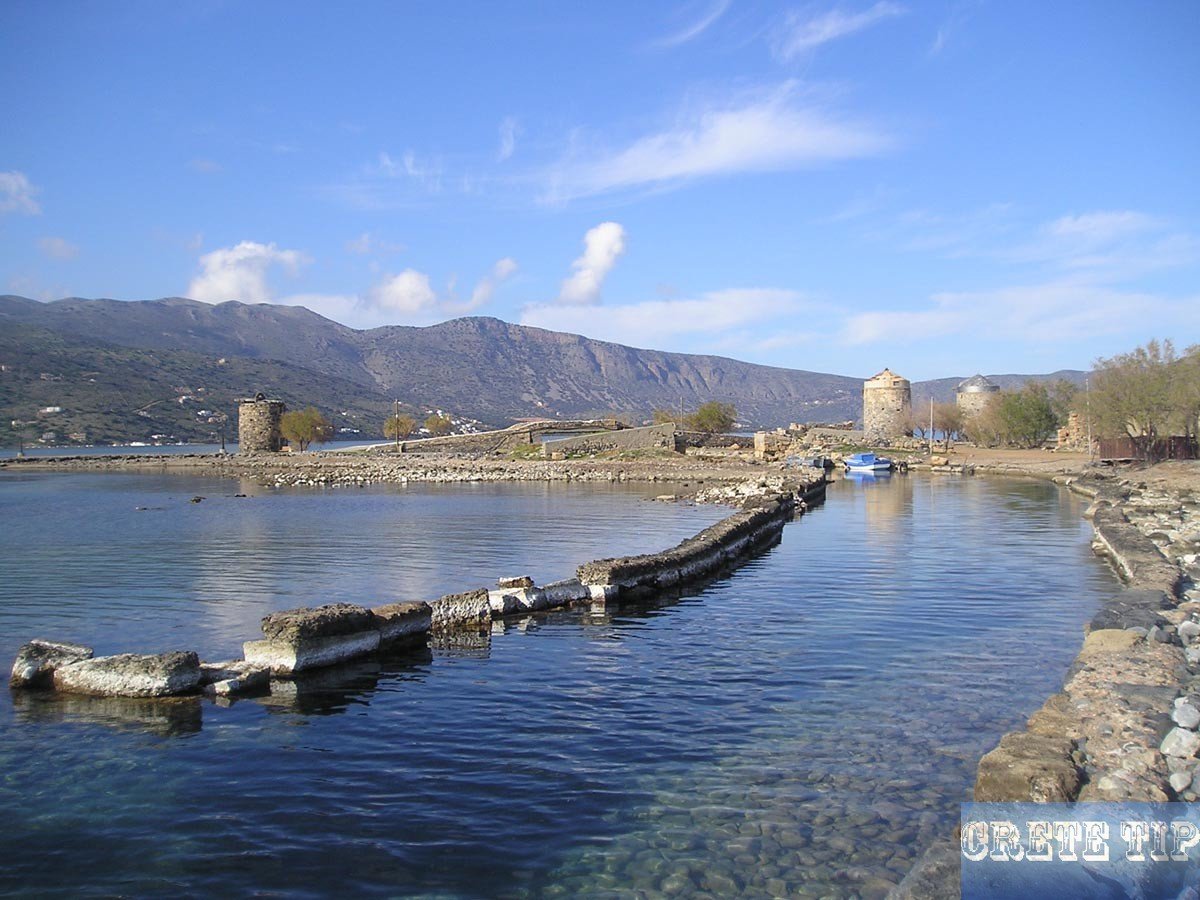
In 2006, a hundred years were completed from the moment that the first person inhabited Schisma, Elounda’s harbour. During this century the village created its own rich history.
Elounda, as it is today, began to be shaped in the 1970s. The first big hotels of the region started to be constructed in 1969 and this fact reversed its physiognomy and its economic activity.
The Elounda Beach Hotel was the first big tourist complex to be ready in this area in 1972. The people, that up to then dealt with the agriculture, the fishery, the production of salt and the excavation of hones, turn to the tourism. The tourism altered the image of the village, which became one of the first tourist destinations in Greece. The village became known worldwide because of the fascinating beauty of its landscape, the island of Spinalonga, its luxury hotels, the high level of tourist services, the arrival of heads of states and personalities of the international politics, the economic and artistic elite.
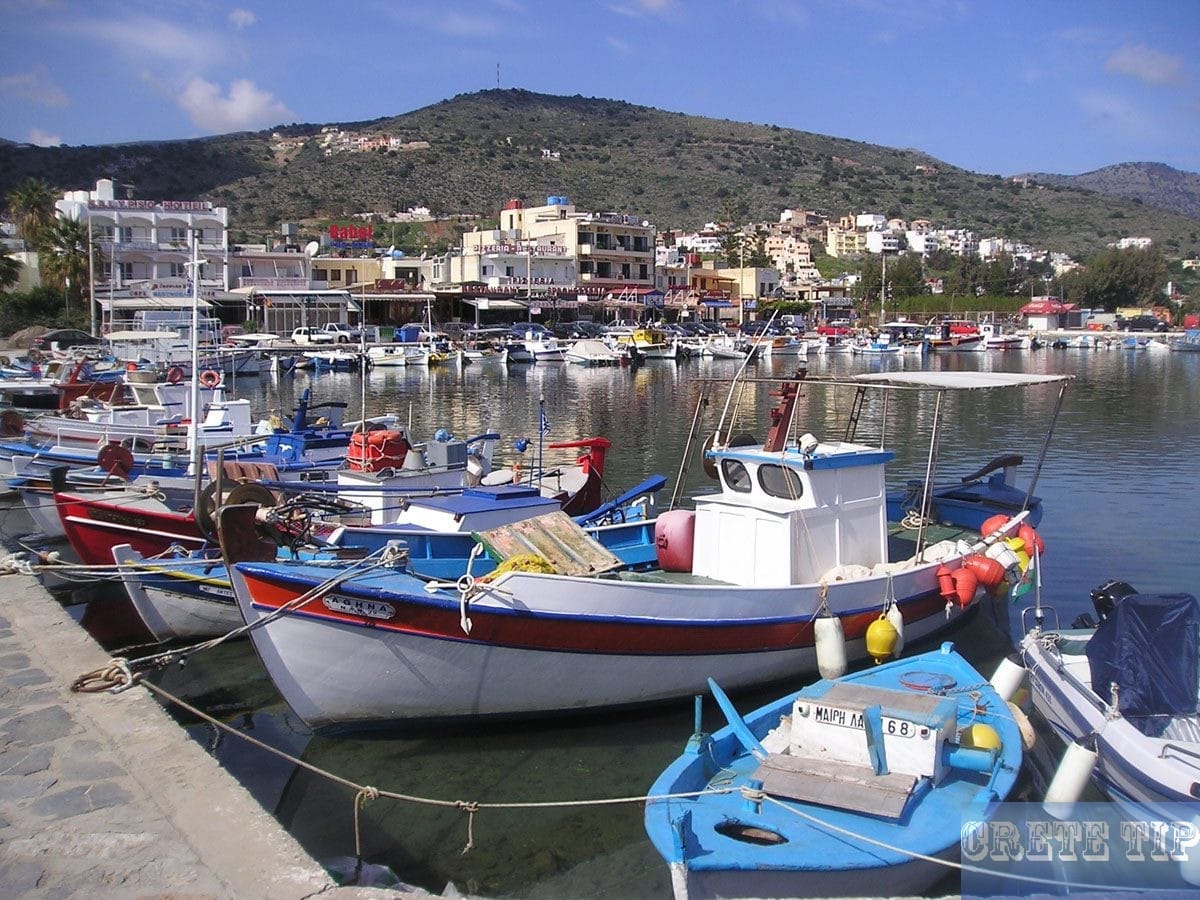
Elounda, remaining such a charming place, has fascinated numerous movie producers in the past, and aside from minor documentaries about the region, there have been a number of greater movie corporations here.
In 1962 Walt Disney created a movie known as The Moonspinners, featuring Hayley Mills, and the village became ‘Agios Georgious’ for a couple of weeks. If you get the chance to watch this movie you could notice a number of quite well-known attractions – particularly at the start. One more film shot here was The Other Side of Midnight – with Spinalonga represented as a high security jail. In 1976 there was the producing of Who Pays the Ferryman? which was shot in particular at the Ferryman’s Taverna and surrounding the port.
Also, for the shooting of the 26-part Greek television movie based on the book ‘Island of the Forgotten’ by Alexis Fielding, a scenic road was built in Epano Elounda (Upper Elounda), depicting a Cretan village 100 years ago. Unfortunately the scenery has been dismantled in the meantime, but here are some more photos of it:
There are several churches in this place, and a number of the tinier kinds anyone can find are usually just used on a single day of the year – to ceremonial a Saints Day for example. The main town churches are commonly bigger, and mounted with amazing frescoes. The Church in the square of the village was finished in 1970, and the frescoes show several amazing legends.
Celebrations in Elounda
Nearly every day is a celebration on whole Crete. The events may be in honor of a Saint, a harvest, a community party, memorial of a legendary struggle, or a nationwide celebration. Some festivities can be found just in particular regions. Just for illustration, on St. Nikolaos Day, Aghios Nikolaos will be the city to celebrate, and all the stores are not open – despite the fact that in other places on Crete there is business is as usual.
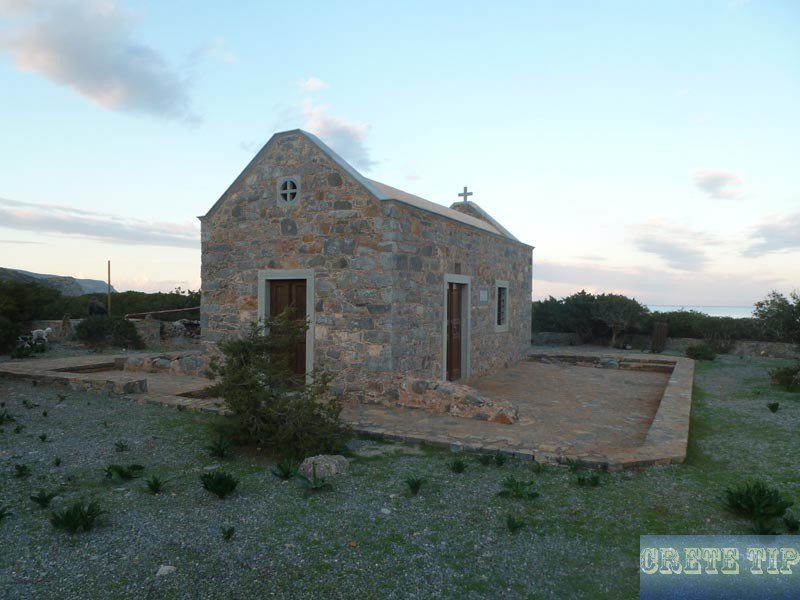
A regular purpose for special event is the ‘Name Day’. To be christened In Greece anyone must come with a Greek Orthodox name, applied from the Orthodox calendar of Saints and Prophets. These Name Days are usually equal significant compared to birthdays, and on important Saints Days there will be unique events in the churches of that name. For instance, on Twenty third April (St. Georges Day) all the Georges as well as Georgias will celebrate and anyone could listen to the hope Kronya Pola, which means ‘many years to live’. Around Elounda churches of St. George exist on Spinalonga and in Pano Elounda, so every person having that name in this community will meet in these churches.
The church in the square of the village is called ‘St. Constantinos and Eleni’, and this Name Day is celebrated on Twenty-first May.
Other festivities involve 25th March – Greek Independence Day; 28th October – ‘Oxi’ Day, when the Greeks defied the Italians in 1940; Carnival Occasion (3 weeks before Lent) – when there are many events and festivals, with everybody outfitting in extravagant dress costumes. Camival period finishes with ‘Clean Monday‘ – no meat is consumed, but there are extraordinary foods for feasting on this particular day (for example Lagana), and the kids may be found around the neighborhoods flying the kites.
Easter is a big celebration on Crete. On Good Friday there is a funeral procession through the streets, succeeded on the Saturday night by an extended church fair along with the climax at midnight, the illumination of candles, and plenty of fireworks. Every person moves home along with the illuminated candles to provide good fortune, and an exclusive dinner of Magiritsa (soup) is enjoyed. Sunday is the day of barbecues, with cooking lamb on the spit.
Elounda from drone view (photos from Xaris Stamos):
The village
At different parts of the shore along Elounda, you’ll observe water running into the sea coming from underground springs. This is certainly freshwater as well as all over a number of these springs have been constructed concrete constructions, together with steps directing right down to sea level. The natives name these spots Vlihades, and in the times when water was not so numerous these were the spots where the housewives could be located performing the day-to-day laundry, or cleaning their veggies as well as fishes. The biggest of Elounda’s ‘laundries’ is in the part of Foumos – around 1 km from the Town on the way to Plaka. These places even now useful to a particular level these days, but today generally for bigger cumbersome goods for example carpets, blankets, olive sacks – or bottle water for livestock, and so on. Over the past decade the usage of cleansers and chemicals in these laundering places was prohibited.
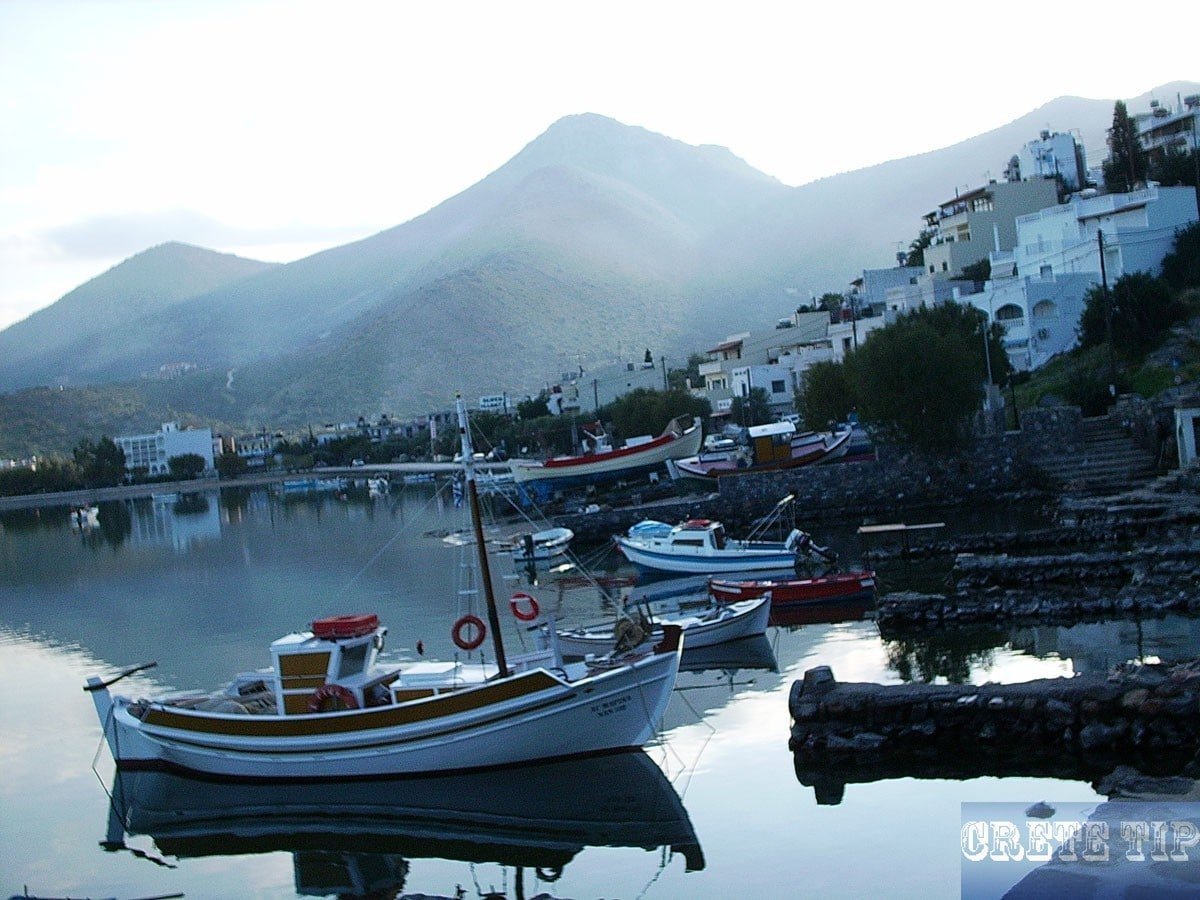
The Cafenion, or Raki Bar, could be explained to be the Greek model of the local pub. 90% of the people are guy’s, and anyone could discover little groups sitting to enjoy cards, tavli (backgammon), studying the magazines, or just speaking. Raki or ouzo is the classic drink always offered with mezes (snacks), however it is likely to find soft drinks and beers, with a simple healthy salad or perhaps omelette. A person may also taste the Greek coffee, which is delivered in a tiny cup complete with coffee grounds which settle in the bottom of the glass.
Landscape image
The region provides its reveal of hedgehogs, bats, badgers, weasels, hares, shrews, mice and rats, and also a great selection of wild birds – such as kingfishers, wagtails, seagulls, herons, partridge as well as quail in order to mention nevertheless some.
The Mediterranean is prosperous with maritime life, and in spite of the improved quantity of tourist ships, water sports and anglers operating in the Gulf of Merambelou it is actually nevertheless possible to watch octopus, squid, seahorses, moray eels, sea turtles, sea snakes, red mullet, snapper, string-ray and starfish – the collection is numerous.
Dolphins have been observed in the greater depth waters exterior the Gulf, and a long time ago it was furthermore likely to find seals in the place outside Spinalonga, on the shore to Vrouhas.
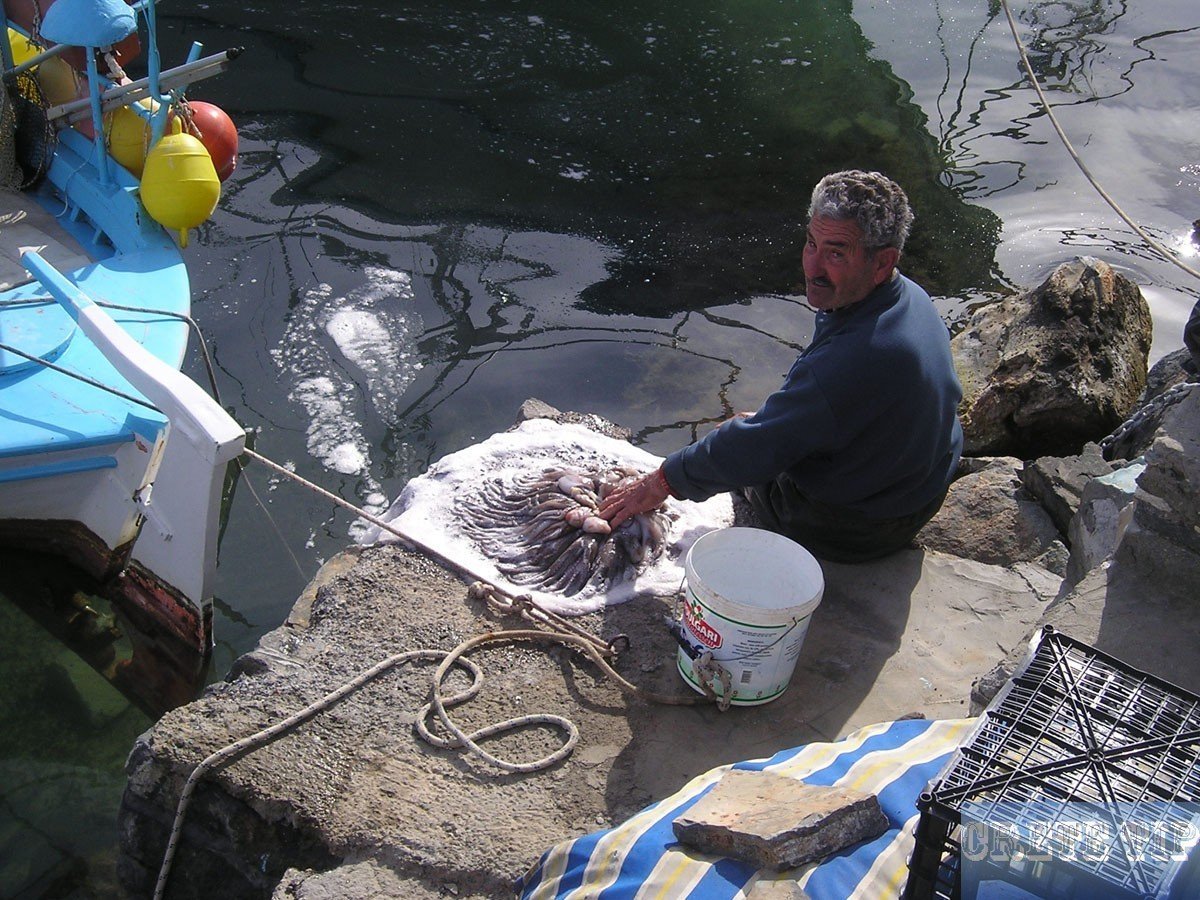
There are a large quantity of olive trees in this region, and these are commonly ready for selecting around November to February – relying on the rain. When the olives are perfect, nets are placed below the olive tree, and branches are chosen in order to bring the olives downwards. They are then gathered and categorized, filled into bags, and transported to the olive plant in Pano Elounda for handling.
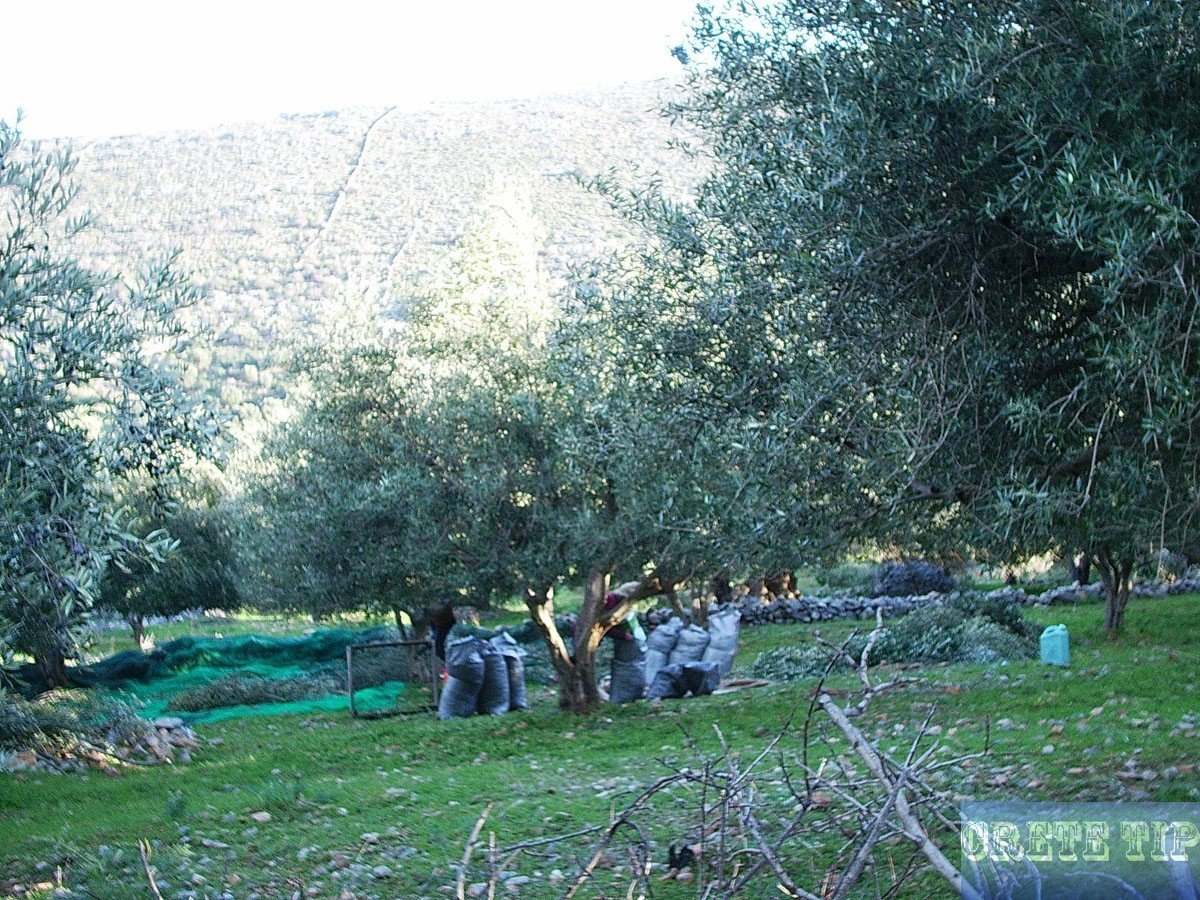
For the duration of February to March the grounds are filled with blooming almond trees, which carry fresh fruit in June and July. Certainly, there are usually furthermore a significant quantity of Carob trees in this region, which carry a fruit similar to a huge dark bean pod. These pods are widely used as animal fodder. Today the residents are likely to overlook the assortment of the walnuts and carob – possibly due to the fact the fruits are ready to be selected in the hectic summer season when the natives have some other agreements. Other trees which can be found at this location consist of lemon, pomegranate, fig and apricot, to mention some.
The stone wall ‘racks’ you can find on the mountain sides were built for various causes. The terrain is extremely stony, so the rocks are shifted to clean the property prepared for farming. These rocks are manufactured into walls which stop the earth from subsiding, indicate the borders of the properties, and hold unwelcome wildlife absent from the plants.
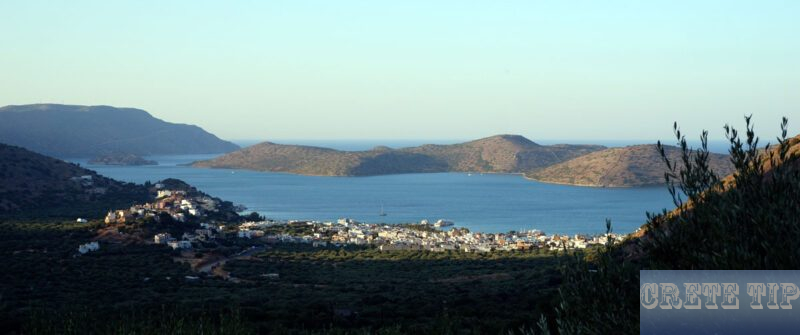
From Elounda there is also a hiking route to ancient Naxos below the top of the Oxa Mountains. The last part near the remains of the old town is not easy to walk, but there is a magnificent view of Elounda and the hinterland from there, as well as Agios Nikolaos right on the other side next to a chapel.
Here are some pictures:
Drone flight towards Aghios Nikolaos and over Elounda from the Oxa Mts
The inhabitants
Throughout the summer season a significant portion of the inhabitants of Elounda are usually engaged in the tourist business. In the wintertime on the other hand, the way of daily life is entirely different. Elounda’s inhabitants are c.2,000 people, and throughout the winter months it results in being really substantially a noiseless fishing town.
The majority of the stores and restaurants close, and aside from fishing the natives can be seen spending their times cultivating the ground or selecting their olives. It is not unusual to watch the shepherds herding their flocks through Elounda, or the donkeys loaded with bags moving up and down from the olive fields.
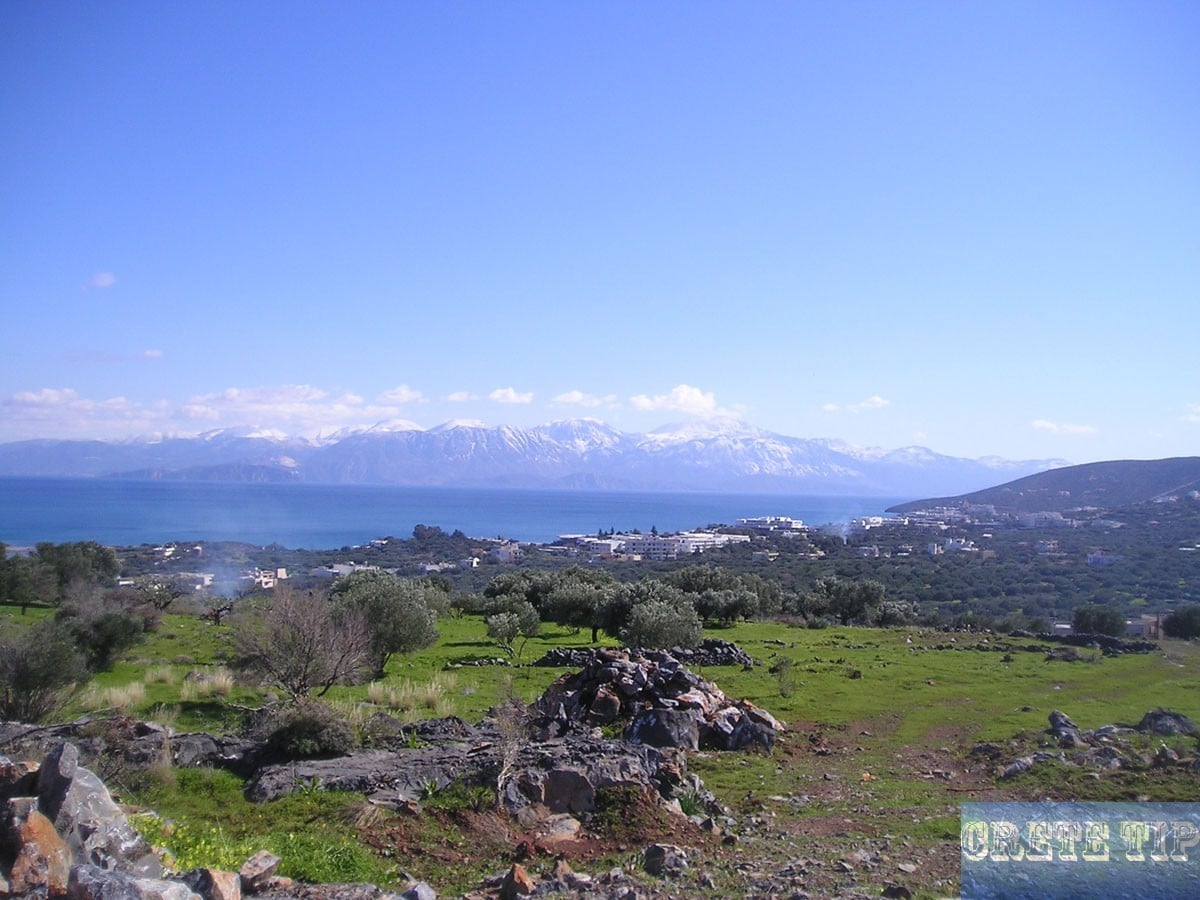
The winter months’ climate is not as extreme as in the other parts of northern Europe, as well as conditions may variety from lovely warm days of 20 °C to the minimum of rarely c. 5°C. October or November sees the first rainfall, but the most rainy and coolest weeks are typically in January and February. It extremely seldom snows in Elounda, but it is possible to find white-colored peaks on the greater mountain tops and all around the plateaus. The most decorative weeks are in the Springtime, when the fields and mountainsides are full of wild flora, such as margaritas, orchid flowers, geraniums, anemones, tulips, cyclamens as well as iris. Herbs such as sage, oregano, rosemary and basil are furthermore in great quantity.
Folks are usually like the climate – as the days become longer as well as hotter the Town starts to bustle again, and everybody can be noticed arranging their stores as well as businesses prepared to welcome the tourists.
Elounda from the drone’s point of view
View from the mountains and the public central sandy beach of Elounda:
Tourism
The tourist growth brought also the residential and demographic growth. The population of the village presented a 43% increase at the last decade. During the summer its population is multiplied astonishingly (more than 550,000 registered overnight stays).
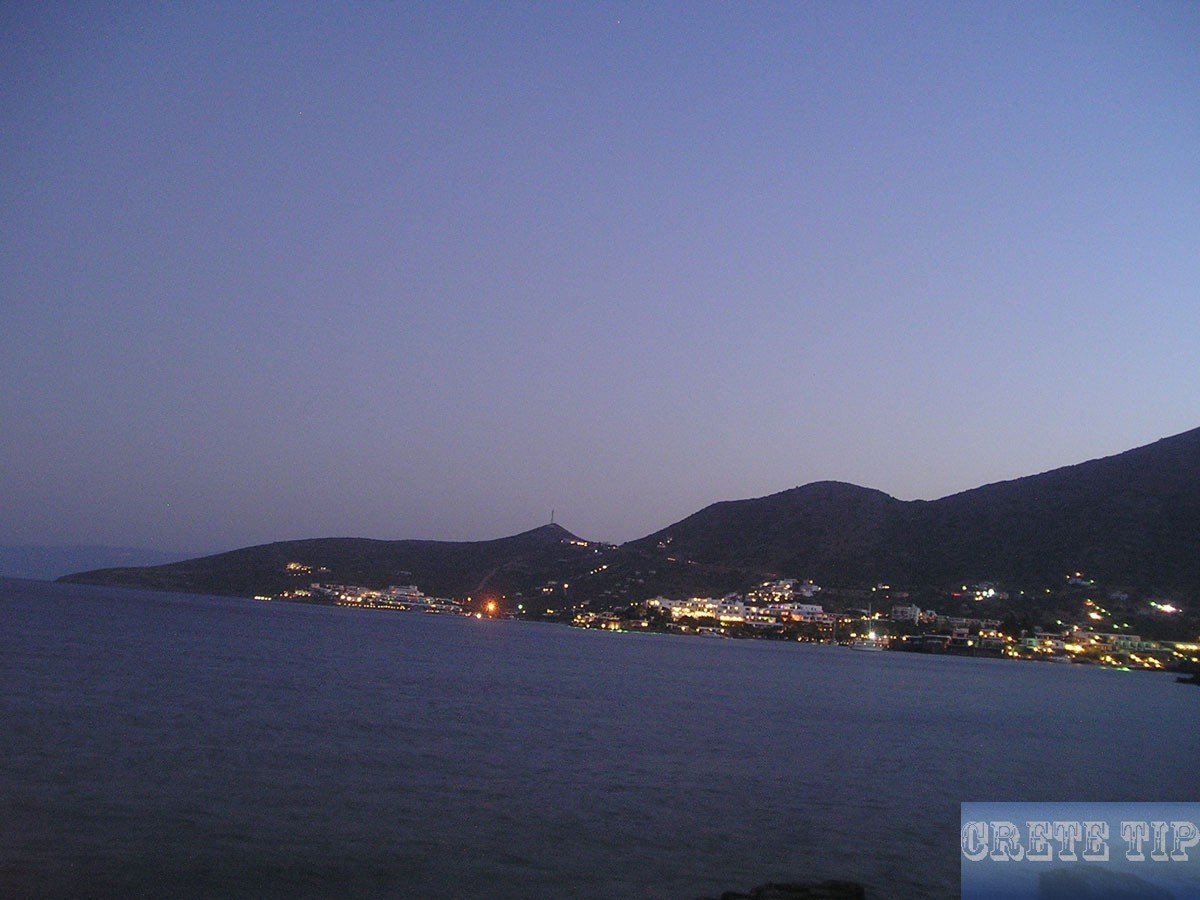
The dynamics of the village is expressed not only by the new hotels and the demographic increase but also by the composition of its population. It attracts persons from all the parts of Greece in order to work at the hotels and the tourist enterprises the festival months, but also a lot of foreigners from Europe and economic immigrants mainly from countries of Eastern Europe.
Between the four settlements that constitute Elounda, the Schisma constitutes the center and the harbor of the village. According to the elements, over 10,0000 individuals visit it daily and more than 207 ships are moored annually.
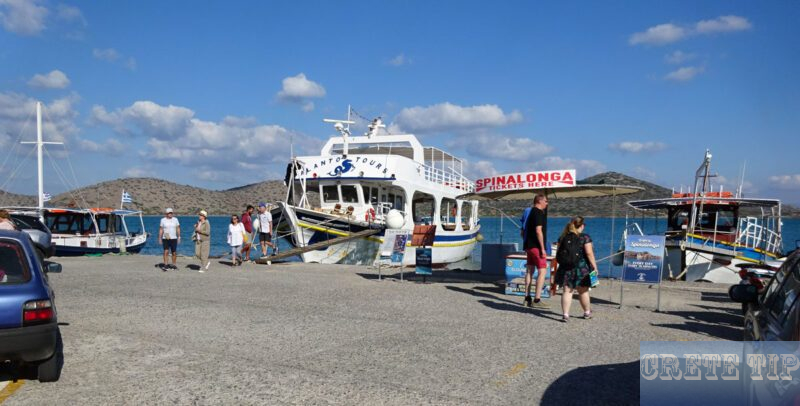
There is a bank and an information office for the visitors, created by the local developmental enterprise of Elounda, Coast Guard harbor outpost, more than 200 tourist enterprises (smaller hotels, apartments and studios, car and bike rentals, tourist shops, restaurants and taverns, supermarkets, traveling agency’s) and more than 7,000 beds from which the half are super luxurious.
Here you could find the latest bus timetable.
Hotels in and around Elounda
Many of the photos, videos and reports available here were taken during a long stay at Corali Studios, where there are self-catering apartments and studios directly behind the public sandy beach.
Overview of available hotels in and around Elounda at the best price!
Animal Welfare around Elounda
Northwest of Elounda, the largest animal shelter in the area is located on the wild and still untouched Aghios Ioannis peninsula: Fino Animal Rescue shelter (close to the small village of Finokalia) which is run by two German expatriates.
In the loneliness on the secluded Aghios Ioannis peninsula, the two are happy about every visit, donations of food or money and voluntary work at the shelter. Probably you could found your favorite dog from Crete for adoption there!
If you love dogs and especially puppies, you should take the opportunity to visit the shelter.
More information and exact directions to Fino Animal Rescue via these two links.
More pictures about Elounda
Video about Elounda
Video about the main public beach and the square of Elounda.
Directions to Elounda
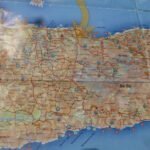
Click here: Directions Elounda.


